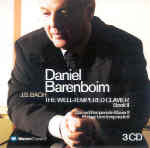Daniel Barenboim’s rhetorical, essentially pianistic approach to Bach’s Well-Tempered Clavier Book 1 proves even more postured and self-aggrandizing throughout Book 2. The pianist applies added bass octaves with less discretion this time, transforming certain pieces into “Bachmaninov” preludes. He employs sudden dynamic shifts and emphatic accents that create sectionalized rather than cumulative effects (for example, the swooning hairpins in the D minor fugue and B-flat minor prelude, the C minor fugue’s blatantly obvious forte/piano alterations, or the contrivances that inflate the F minor prelude to Wagnerian dimensions). Barenboim tastelessly rushes the D major prelude’s upward scales while dispatching the F minor fugue and G-sharp minor prelude with heavy, humorless hands.
As before, Barenboim employs his prodigious portfolio of pianistic devices with an aim to underline the music’s harmonic tension, yet it often obscures the direction of individual lines. This occurs mainly in his soft playing, and in the way fugal entrances trigger subsidiary lines to duck, cover, and murmur in the background. Granted, the D-sharp minor, G major, and B-flat major preludes show that Barenboim can play Bach lightly, straightforwardly, and simply. Too bad he chooses not to most of the time. Not surprisingly, Barenboim’s adjustments to the basic pulse and frequently slow tempos require three rather than the usual two CDs alotted for Book 2. If old-world Bach pianism appeals to you, the old Edwin Fischer and Samuel Feinberg WTC cycles convey two key qualities that Barenboim lacks: joy and humility.
































